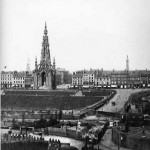15 Oct Sir Jack’s Edinburgh
 Sir Jack Stewart-Clark writes an introduction for the monthly ‘Luxury Edinburgh’ newsletter.
Sir Jack Stewart-Clark writes an introduction for the monthly ‘Luxury Edinburgh’ newsletter.
One of my favourite books is called ‘The Railway Man’. It was written by Eric Lomax and brilliantly describes his quiet traditional upbringing in Edinburgh and his subsequent but terrible experiences under the Japanese as a Prisoner of War.
His story begins with a boyhood recollection of those magnificent steam trains, which puffed their way out of Edinburgh’s two great terminals at the two ends of Princes Street. One serving the LNER (The London and North Eastern Railway) and the other the LMS (London Midland and Scottish) railway, which sadly became a victim of the Beeching axe in the late 1960’s. The author also vividly describes the Edinburgh trams, which trundled up and down Princess Street and beyond until November 1956 when the line was closed and the carriages dismantled. He describes how, after introduction in the late nineteenth century, they were pulled by cable from a large central station in Portobello and only later became electrified. I too remember these great transport innovations from my early childhood with wonder and nostalgia.
It is now a turn of the wheel of history that once again we are to see sleek fast trams in Edinburgh and, who knows, an ultra-fast railway line from our city to London. History does indeed repeat itself and other examples exist both in Edinburgh and its surrounding areas. Nowhere is this more evident that on the great river Forth, which helps, as it has always done, to give our capital city its wealth and its vibrancy. A perfect example is the great cantilever bridge across the Forth, which was completed in January 1890. It is one of the world’s great engineering achievements Now one hundred and nineteen years later we see a road vehicle and complimentary suspension bridge, which is already over-crowded and due to be replaced by yet a third Bridge. What a comparison with my childhood days when we waited patiently at the South Queensferry pier for the ferry that would transport the family and our car for our journey to Fife, Perthshire and beyond. That was a major expedition!
I doubt if even the wisest of seers could have imagined the incredible evolution and dynamic expansion which has taken place in the city of Edinburgh and along the Forth over preceding centuries but especially in the last 100 years. My own home, at Dundas Castle, is a good example. It was the seat of the Dundas clan from the eleventh century until the middle of the nineteenth century. The early fourteenth century Keep is completely original but it has now been preserved by extensive restoration. The main house, built in 1818 by the famous architect William Burn, has also been totally renovated. My wife and I and our team have turned the Castle into a five star luxury venue which is ideal for romantic weddings, conferences and special occasion functions. Would any of the Dundas ancestors or those earlier members of my own family, which acquired Dundas Castle in 1899, have imagined the change and progress which has been made? I doubt it.
Further along the Forth you find that architectural masterpiece, Hopetoun House, with its superb designs by Sir William Bruce and William Burn. I call Hopetoun, ‘my grand neighbour’ because of the opulence and magnificence of the building and its contents. They too provide excellent facilities and first class service for all manner of functions.
A more recent star in the firmament of Edinburgh has been the arrival of the Royal Yacht Britannia. Formerly the floating home of Her Majesty the Queen and the royal family, it was ‘retired’ and is now a top visitor attraction. Small wonder since it is full of royal history and nostalgia.
Edinburgh is fascinating is so many ways, but literally above all is Edinburgh Castle itself. The greatest of all Scotland’s fortresses with a history reaching back into antiquity. It also houses the Crown Jewels of Scotland, which are a ‘must see’ for any visitor.
A visit to Edinburgh Castle and experiencing its treasures can be complimented by lunching or dining at ‘The Witchery’. This is one of the most historical and best run restaurants in the city. Located on the run up to Edinburgh Castle’s esplanade it makes the most ideal finish to anyone’s day out in Edinburgh.
Finally mention must be made of the Edinburgh Music Festival. Since 1945 it has grown into the world’s most diverse and top quality arts festival. Under its new Director, Jonathan Mills, it will surely go from strength to strength with a myriad of theatre, music, ballet and works of art from all over the world. Alongside has grown the Edinburgh Fringe, the Edinburgh Book Festival, the Edinburgh Jazz Festival and the Edinburgh Film Festival. Can anyone doubt that Edinburgh has become one of the greatest arts cities in the world?
My favourite venue for music in Edinburgh is the Usher Hall. Frequently my wife and I will dine at the Sheraton Hotel, which is opposite the Usher Hall. A better place for a pre-concert supper I cannot imagine.
So Edinburgh for me is the fairest of all cities. It is one of the most interesting, historical and cultural cities in the world. And I have not begun to mention Edinburgh as a Financial Centre, as the gateway to the Highlands and above all for the warmth and welcome of its people. That would take up the pages of a book!


